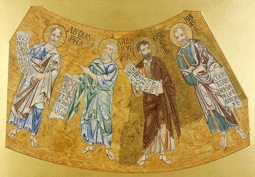Study of Mosaic: 'Obadiah, Habakkuk, Hosea and Jonah'
Eastern Dome, San Marco, Venice. Thomas Matthews Rooke (1842-1942). Watercolour, bodycolour and gold on paper, 1879.
WorkRuskin commissioned Rooke to produce accurate copies of the mosaics so that a record would exist in the event of their destruction.This work was done, in Ruskin's words, for 'love and journeyman's wages' (Works, 24, p. 334), and lasted between early May and early December of 1879.Rooke complained that work was interrupted frequently by festivals and Saints' days (Works, 30, p. lvii). Ruskin replied jovially, 'Never mind interruptions', 'They refresh and clarify one's sense [...] Take them as holidays ordered by the Saints, and enjoy them all you can'.Unfortunately, many of Rooke's drawings of the mosaics were destroyed by a fire in the St Gothard Tunnel. On his return, he did his best to reconstruct them from surviving tracings.
ArtistT.M. Rooke (1842-1942) created many watercolour drawings for the Guild of St George. He first worked in an army agent's office before attending evening classes in art and became a student at the Royal Academy in 1868. The following year he was employed by William Morris's firm and became an assistant and close friend of Edward Burne-Jones.Rooke enjoyed success as an artist in his own right. He painted large biblical scenes in a style influenced by Burne-Jones and Renaissance art, and exhibited at the Royal Academy. Collection of the Guild of St George, Museums Sheffield
When Ruskin employed him, Rooke worked in a different style, drawing in watercolours and painting from life. Later, Rooke painted records of architecture for the Society for the Preservation of Pictorial Records of Ancient Works of Art.
Ruskin on MosaicIn the course of his correspondence with Rooke, Ruskin wrote that 'The real fact is that all Byzantine mosaic (and all Eastern colour) has splendour for its first object -- and its type is the peacock's tail.'He adds, for Rooke's benefit, that 'If your drawings glow and melt like that you are right': 'Peacock's tail in shade or light it may be -- and much sober brown in any light may mix with its violet and gold -- but that is what the mosaicist wanted to do, and for the most part did'.Ruskin concludes, provocatively, that 'All that is grey, cold, reserved, or modest, in these mosaics (in any other sense than a humming-bird or flamingo or pheasant -- or aforesaid peacock -- is modest) is European, mostly Roman, some of it German -- all of it bad.' (Works, 30, p. lviii). |



















